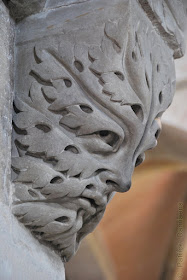The Green Man or Acanthus Man.
The “Groene Man” is the Dutch translation of the English term 'Green Man'. Although less well known than in neighboring countries Green Men are also commonly found in the Netherlands and Belgium. In the literature it is also referred to as a mask of leaves or acanthus man.
The “Groene Man” is the Dutch translation of the English term 'Green Man'. Although less well known than in neighboring countries Green Men are also commonly found in the Netherlands and Belgium. In the literature it is also referred to as a mask of leaves or acanthus man.
 |
| The Bamberg Green Man | Bamberg horseman |
Not long ago I was a guest for few
days in Bamberg, in the northern part of Bavaria, in Germany. The historic
center of Bamberg is very beautiful and has much to offer, especially in the
cultural field and has numerous historic buildings, museums and churches.
One of the attractions that I had on
my list of “things to see” and that should not be missed was the “Groene Man” or the Green Man in the Bamberg Cathedral.
The Green Man from Bamberg Cathedral is an ornament – console/corbel made of sandstone which works as support of the Bamberg horseman, a beautiful sculpture from around 1240. The Bamberg Green Man console/corbel from the 13th century is an acanthus leaves motif, and has a nice human form, this type of ornament is a beautiful example, and it is one of my personal favorites.
The Green Man from Bamberg Cathedral is an ornament – console/corbel made of sandstone which works as support of the Bamberg horseman, a beautiful sculpture from around 1240. The Bamberg Green Man console/corbel from the 13th century is an acanthus leaves motif, and has a nice human form, this type of ornament is a beautiful example, and it is one of my personal favorites.
Ornament
A
Green Man is usually an
ornamental addition or embellishment.
Most Green Men are found in Christian churches, finding the vast majority in England, France and Germany and were mainly used in Western architecture from the 11th to the 16th century. They are not always easy to recognize, often they are hidden behind stalls or are located high in the structure of the ceiling, but mostly they are just in plain sight and on columns, corbels or above the main doorways.
Most Green Men are found in Christian churches, finding the vast majority in England, France and Germany and were mainly used in Western architecture from the 11th to the 16th century. They are not always easy to recognize, often they are hidden behind stalls or are located high in the structure of the ceiling, but mostly they are just in plain sight and on columns, corbels or above the main doorways.
In
terms of size, they range varies from small
images to life-size images. They can
also be found, although less frequently,
in other secular and ecclesiastical
buildings or to decorate the graves and memorials.
The
interior of a Green Man can be made of stucco or feature
polychrome. They could be made of wood
and found in church furniture.
Generally it is a human head, but
it can also be an animal figure. From the openings of the face grow branches with leaves or a composition of acanthus leaves. The often
fierce-looking figures were made to keep away the
evil spirits. This use was already
known throughout Europe for many
centuries. Celts, Greeks and
Romans knew that the heads would have vegetation
growing through the holes of the face.
Also in ancient Asian and American cultures this figures were used.
The
Green Man is seen as the archetype of
the male productive
energy of the earth. In ancient mythology of many
cultures it is the companion of
Mother Nature, and their lusty association
creates fertility every spring, again and again.
The figure of Christ was portrayed too as a Green Man; having a plaited crown of thorns leaves growing out of his head.
In England, the Green Man is a popular part of the tradition. Quite a few pubs are called The Green Man, because the image at the entrance. In a Scottish church, the Rosslyn Chapel in Roslin in Edinburgh, more than 100 images of a Green Man were found.
Translation, Lis Alvar R
Here are some images of the
Bamberg Green.
_____________________
____________________
 |
| The Bamberg Green Man |
 |
https://www.patrickdamiaens.info |
 |
| Link to our FB Page |




No comments:
Post a Comment